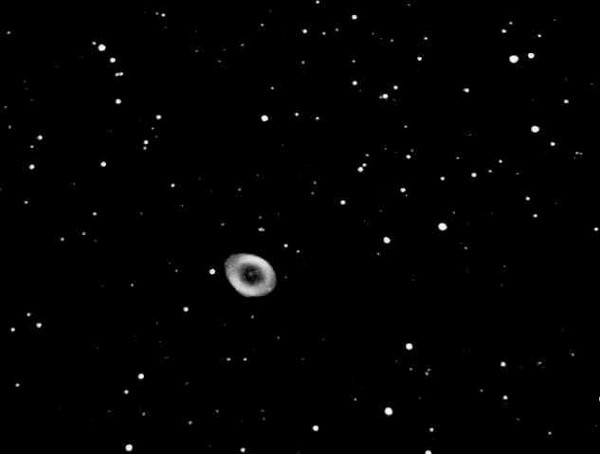When you look out at the nebulae in the night sky -- especially if you're seeing them with your eye through a telescope for the first time -- you might be in for a big surprise.
 Image credit: Chris Spratt of http://www.islandnet.com/.
Image credit: Chris Spratt of http://www.islandnet.com/.
These faint, fuzzy, extended objects are far dimmer, sparser and more cloud-like than almost anyone expects. Yet thanks to some incredible image processing, assigning colors to different wavelengths and adjusting the contrast, we can make out detailed structures beyond what even your aided eye could ever hope to perceive.
 Hubble images of M57 taken at wavelengths (in nanometers) of 658 (red), 502 (green) and 469 (blue), color-coded and composited by Brian Koberlein.
Hubble images of M57 taken at wavelengths (in nanometers) of 658 (red), 502 (green) and 469 (blue), color-coded and composited by Brian Koberlein.
Check out the latest from Brian Koberlein on the illusion of reality over at Starts With A Bang!
More like this
“The universe is big, its vast and complicated, and ridiculous. And sometimes, very rarely, impossible things just happen and we call them miracles. And that’s the theory.
"For most people, we often marvel at the beauty of a sunrise or the magnificence of a full moon, but it is impossible to fathom the magnitude of the universe that surrounds us." -Richard H. Baker
When our science fiction fills our heads with ideas that could make our lives tremendously improved, we like to believe it's only a matter of time before technology catches up with our imaginations.
No one science can stand wholly on its own. For inquiry about the Universe to give a correct, complete picture, it requires that we bring in a whole slew of evidence, often from tangentially related fields.

It's wonderful that humans precieve things
so abstractly . Learning from the way we precieve in a natural visual effect and from a more complex sence , through our understanding of science .
Agree absolutely that the enhanced photos show more information. Moreover the enhanced images are real in the sense that the data is not fabricated by the sensor. Also what the eye sees naturally is not more real, but the result of processing in the eye and brain that has been driven by evolution to provide useful data to primates primarily during daylight. The enhanced photos represent the best "eyes" we can engineer using the color channels available to human visual processing. Finer sampling of the spectra, or additional filters beyond three (say tuned to different element spectra), would require restructuring our memory, an enhancement not available yet.
This subject of discussion is very easy to agree if we remember that photography in science is very recent in our human history.
And that famous scientists of the early days of photography were not convinced on using photography to document their researchs. They used to draw what they saw.. Even in astronomy, but also in biology. And just drew what they wanted to remark. intentionally skipping the rest. Sometimes, using artificial colors (remember Ramon & Cajal colouring the cells). So, they could not imagine how to do the same with photography.
The concept that photographic images have to closely resemble what we see is a more contemporary illusion. But remember that todays paintings are far more distant of this idea than photography.
The final "paired" image of the Ring Nebula in monochrome and false color full spectrum views is incorrectly oriented. The second color view should be rotated 90 degrees clockwise and reduced in size about 35% to match the monochrome view.
Technology has enhanced our eyes from the invisable world of molecules to the giant world of galatic dimensions. Sometimes it is used to deceive us and enchance our own appearance by deceptive air brushing of photographs. Photography is no longer believable evidence, faking reality is becoming easier.
The boundaries of reality are no longer clear.
@#5, magnocrat
There is no argument as to the misuse of photo manipulation in the media. The difference in science, though, is that it is used as a TOOL to advance our understanding of the subjects we observe. Invariably, the notations given with each plate states the method used to achieve the result. No dishonesty is forthcoming from this process.
Thanks Ethane,
Is it the illusion or realizing of the realities?
There's a scientific term that encompasses part of what you're talking about.
The term is "memory color" which color scientists use to talk about colors that humans associate with a particular object such as the red of a stop sign or the yellow of a banana. These "memory colors" can replace the real color of an object in your brain. It also works in reverse, your memory of colors is influenced by a number of factors, and it's why you can be disappointed when your vacation snapshots don't show the vivid colors you remember.
What I'm trying to say is that the human color perception system is very complex and still full of mysteries. So at this point trying to argue that one set of color renderings is more accurate or truthful than another is sheer speculation. Let's wait until the astronauts get back from Jupiter and they can tell us what the planet really looks like.
Shame on you Ethan! I love your column, but even you know you're jus scoring points with such a headline.
Any high school science student should know that as long as the images are based on real data they are no more lies than is a cat-scan, an x-ray, or a microscope image, all of which give us enhanced images that don't show things the way the eye sees them.
Of course you might have a point with the colorized electron microscope images that have become de rigeur.